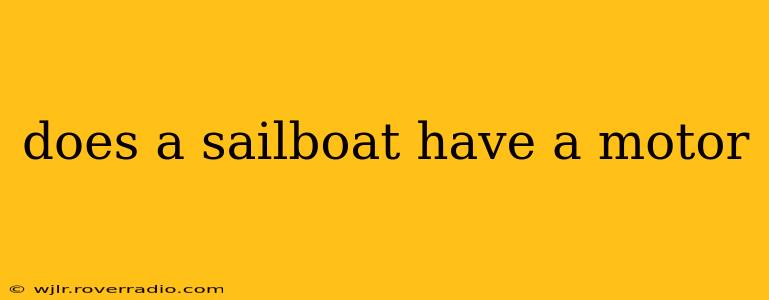Does a Sailboat Have a Motor? The Surprising Answer
The short answer is: sometimes. While sailboats are designed to harness wind power for propulsion, many—perhaps even most—modern sailboats are equipped with auxiliary motors, often called "inboard" or "outboard" motors depending on their placement. The presence or absence of a motor depends on several factors, making the question more nuanced than a simple yes or no.
Why Do Some Sailboats Have Motors?
The primary reason sailboats are often equipped with motors is for maneuverability and safety. Here's a breakdown:
- Entering and Leaving Harbors: Sailboats rely on wind. In calm conditions or tight harbor environments, a motor becomes essential for safe and controlled navigation. Tacking (changing direction) in confined spaces can be difficult and even dangerous without engine power.
- Emergency Situations: In the event of equipment failure or unexpectedly adverse weather conditions, a motor provides a vital means of escape or reaching safety.
- Cruising in Light Winds: While sailing is ideal, long voyages often involve periods of light or no wind. A motor allows for continued progress and avoids being becalmed for extended periods.
- Convenience: Motors offer ease and convenience, particularly for docking, maneuvering in crowded marinas, and general control.
What Types of Motors Are Used on Sailboats?
Sailboats utilize various motor types, each with its own characteristics:
- Inboard Motors: These motors are installed inside the boat's hull, offering a quieter and more integrated experience. They generally provide more power and are better for larger vessels.
- Outboard Motors: These are attached to the stern (back) of the boat and are easily detachable. They're often more affordable and simpler to maintain than inboards.
- Electric Motors: Increasingly popular, electric motors offer quiet operation, lower emissions, and potentially lower running costs.
What Kind of Sailboat Doesn't Have a Motor?
Some sailboats, particularly smaller racing dinghies or some older, classic designs, may not have motors. This is often a deliberate design choice prioritizing speed, weight reduction, and simplicity for racing or specific sailing styles. However, even in these cases, the boat might be equipped with an emergency rowing system.
How Big Is the Motor on a Sailboat?
The size and horsepower of the motor vary greatly depending on the size and type of sailboat. Larger, heavier cruising boats typically have larger engines (20-50 horsepower or more), while smaller sailboats might have much smaller motors (5-15 horsepower). The engine size is carefully chosen to provide adequate power while keeping the boat's overall performance and handling characteristics in mind.
Are Sailboats with Motors Still "Sailboats"?
Yes, absolutely! The presence of an auxiliary motor doesn't diminish the essence of a sailboat. It simply provides a practical and necessary tool for enhancing safety, maneuverability, and overall usability. The primary mode of propulsion remains the sails, with the motor acting as a supportive, secondary system.
This comprehensive look at sailboats and their motors addresses the core question and dives into related inquiries, offering a well-rounded and informative response.
